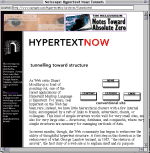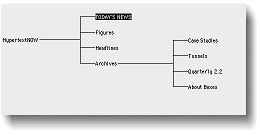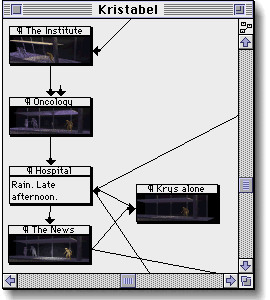recurrence is not a vice
On the Web, almost everything is composed in Hypertext Markup Language, and almost nothing is hypertext.
The history of hypertext is littered with fruitless debates over what is, and what is not, a "real" hypertext. At one point, people thought that hypertext meant "having bidirectional links". At one point, people thought that hypertext meant "having a graphical map of nodes and links." Few believe this today.
The point here is not to revive the fruitless debate over whether a particular work is or is not a hypertext. Hypertext tools can often be used to for writing that is not particularly hypertextual. This is a virtue.
The point is to distinguish links that create structure and express ideas from navigational apparatus that aids site management or provides access.
That is blue text. Turning text blue doesn't make it hypertextual. (Turning text blue does make it distracting; see a past issue of HypertextNOW for a discussion of ways links can be made visible.)

This is not a hypertext. It's a picture of a page of HypertextNOW [as it appeared in 1996–ed]. The actual page has a number of links you can follow, but they simply lead to other, separate discussions. They are points of departure, not part of the writing; the actual page is part of a docuverse but not part of a hypertext.

This is not a hypertext. It is a map of HypertextNOW. The links are simply hierarchical, like so many links you find in today's Web.
This structure isn't designed to help you; you don't really care whether a given topic is in the archives or in Today's News. The structure is designed to help us edit and maintain the web site; because there is a new edition three times a week, we want to make it easy to add material and don't want to think too deeply about how the new ideas relate to what has been said before.
recurrence is not a vice
 This, on the other hand, really is a piece of a hypertext.
This, on the other hand, really is a piece of a hypertext.
It's not a hypertext because it has boxes; that's just a drawing.
It's not a hypertext because it has links.
It's a hypertext because those links create structure for the reader. Notice the cycle near the writing space named "Hospital"; readers may leave the hospital, but they often return. (This echoes the experience of one of the characters in this story, a cancer patient.)
In this hypertext (which happens to be written in Storyspace), conditional links called guard fields ensure that the reader won't be caught in a loop. Each departure from the hospital leads to a new path; the reader's past choices influence what may happen later in the reading. The recurrence of the hospital, like a a song's refrain, creates a framework that makes the changes more meaningful.
On many web sites, the only recurrence is the home page. This is often a wasted opportunity.
Some early hypertext studies believed that recurrence -- returning to a writing space more than once -- was a sign of inefficient structure or a symptom of disorientation. This was plausible, but turns out to be wrong. Recurrence is the main way that people perceive a hypertext structure, the way they learn what contours they may follow and how those contours may change as the document evolves.
